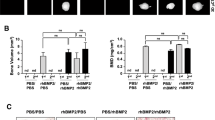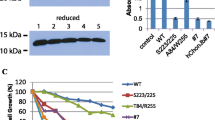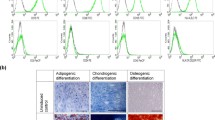Purpose:
Heterotopic ossification (HO) is a common complication following total hip replacement. Clinical studies showed the effectiveness of irradiation for prevention of heterotopic ossification. The mechanism of radiotherapy responsible for the reduction of heterotopic ossification is unclear. The purpose of this study was to find a suitable cell system, which can reproduce in-vitro data resulting from clinical in-vivo studies. The establishment of such a cell model allows detailed analyses of the mechanism of radiotherapy.
Method: The chicken limb bud test was used as an in-vitro model. The cells acquired by the limb bud test were irradiated with different doses (0 Gy, 3 Gy, 7 Gy, 10 Gy, 20 Gy). Irradiation was set either 1 hour before, or 1 or 3 days after BMP-2 incubation. The synthesis of proteoglycans (PGS) upon treatment with bone morphogenetic protein (BMP)-2 was measured in cells incubated with BMP-2 for 4 days followed by 35SO4 2− labeling for 6 hours. Labeled proteoglycans were precipitated using Alcian blue and measured in a raytest radio-TLC analyzer. The incubation with BMP-2 was defined to correlate the in-vivo stimulus meaning the operation.
Results: The proteoglycan synthesis was significantly reduced by irradiation 1 hour before or 1 day after BMP-2 incubation, if the dosage was at least 7 Gy. Higher doses than 7 Gy did not lead to lower proteoglycan levels. There was only a trend for a reduction of proteoglycan synthesis by 3 Gy irradiation, but no significant difference compared to the non-irradiated control. An irradiation 3 days after BMP-2 incubation had no effect on proteoglycan.
Conclusion: A dose and time dependent effect of radiation on BMP-2-induced proteoglycan synthesis was observed. Therefore the results of clinical in-vivo studies were reproduced exactly by the limb bud test. We established an in-vitro cell model to analyze the mechanism of the prevention of heterotopic ossification by radiotherapy on cellular or sub-cellular level.
Hintergrund:
Heterotope Ossifikationen stellen eine häufige postoperative Komplikation nach Hüftgelenksoperationen dar. In klinischen Studien konnte gezeigt werden, dass eine Bestrahlung des Operationsbereichs Ossifikationen verhindern kann. Dabei ist der genaue Wirkmechanismus der ionisierenden Strahlen unbekannt. Ziel dieser Untersuchung war es, ein geeignetes Zellsystem zu finden, welches die aus der klinischen Beobachtung gewonnenen Kenntnisse in vitro reproduzieren lässt, um damit ein Modell zu haben, den Wirkungsmechanismus der Bestrahlung analysieren zu können.
Material and Methode: Als In-vitro-Organmodell wurde der Limb-Bud-Test gewählt. Die dabei gewonnenen embryonalen mesenchymalen Zellen wurden mit unterschiedlichen Bestrahlungsdosen (0 Gy, 3 Gy, 7 Gy, 10 Gy, 20 Gy) zu unterschiedlichen Zeitpunkten bestrahlt (1 Stunde vor, 1 und 3 Tage nach Zugabe von Bone Morphogenetic Protein [BMP]-2). Die Zellen wurden 4 Tage mit BMP-2 und anschließend für 6 Stunden mit 35SO4 2− inkubiert. Die so markierten Proteoglykane wurden mittels Alcian-Blau gefällt und in einem Raytest-Radio-TLC-Analyzer gemessen. Die Inkubation der Zellsuspension mit BMP-2 entsprach dabei der in vivo als Ossifikationsreiz geltenden Operation.
Ergebnisse: Die 1 Stunde vor oder 1 Tag nach BMP-2-Zugabe bestrahlten Zellsuspensionen zeigten eine deutliche Abnahme der Proteoglykansyntheserate (PGS), sobald die Bestrahlungsdosis mindestens 7 Gy betrug. Eine Steigerung der Dosis bis zu 20 Gy führte nicht zu einem weiteren Abfall der Proteoglykansyntheserate. Für eine Dosis von 3 Gy fand sich lediglich ein Trend zu einer reduzierten Proteoglykansynthese, ohne dass der Unterschied zur unbestrahlten Kontrollgruppe signifikant gewesen wäre. Eine Bestrahlung 3 Tage nach BMP-2-Zugabe hatte keinen Einfluss auf die Proteoglykansyntheserate.
Schlussfolgerung: Der Limb-Bud-Test erlaubt es, die Ergebnisse der klinischen Studien in vitro zu reproduzieren. Man hat damit ein Zellmodell zur Verfügung, das es erlaubt, auf zellulärer und subzellulärer Ebene den Wirkungsmechanismus der ionisierenden Strahlen bei der Verhinderung ektoper Ossifikationen zu untersuchen.
Similar content being viewed by others
Author information
Authors and Affiliations
Additional information
Received: March 12, 2001; accepted: June 19, 2001
Rights and permissions
About this article
Cite this article
Koelbl, O., Knaus, P., Pohl, F. et al. Radiation-Induced Reduction of BMP-Induced Proteoglycan Synthesis in an Embryonal Mesenchymal Tissue Equivalent Using the Chicken “Limb Bud” Test. Strahlenther Onkol 177, 432–436 (2001). https://doi.org/10.1007/PL00002425
Issue Date:
DOI: https://doi.org/10.1007/PL00002425




